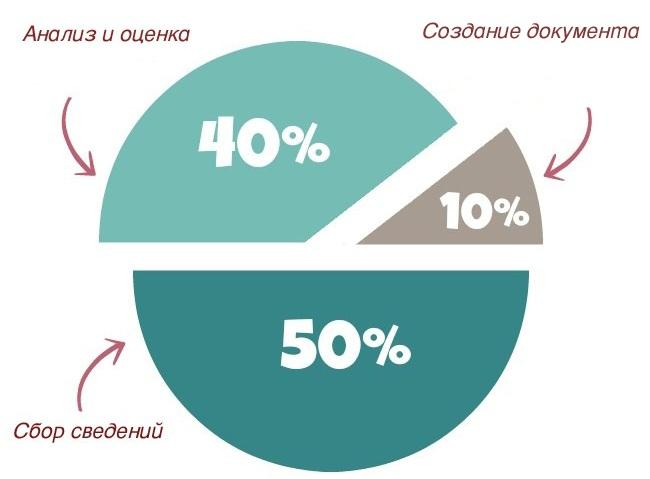Instructions for developing a marketing plan for a company: where to start?
Alexander Kaptsov
Reading time: 11 minutes
A A
The formation of a stable array of buyers, finding their niche in the market, suppressing competitors, building a plausible reputation - this is not a complete list of issues that entrepreneurs have to solve. Without a clear marketing plan, it is almost impossible to achieve stable demand for products, brand recognition, and a large number of loyal customers. How to properly compose this important document for any business?
Marketing plan of the company - what is it?
Under the company's marketing plan should be understood the details of all its actions that are focused on achieving its optimal position in the market. It does not affect the production and technological aspects of the functioning of the company and only affects the sale of products and profit.
Benefits of developing a marketing plan for a company:
- Firstly , determines which part of its funds will have to be spent on marketing activities.
- Secondly , to form a policy of promotion on the market of specific types of goods and services.
- Thirdly , draw up a strategy and tactics for working with the target market, including the procedure for setting prices.
- Fourth , certain goods, sales proceeds and profits.
Important point: Since the marketing plan draws in detail all marketing activities and expected results, it is possible to trace the effectiveness of certain approaches in the company's activities in the market.
Types of the company's marketing plan and the purpose of their preparation
There are many criteria for classifying marketing plans, including:
- Duration of validity - strategic (more than 3 years), tactical (up to 3 years), operational (up to 1 month).
- Coverage - a plan for turnover, sales, promotional activities, market research or integrated (comprehensive plan).
- Depth of study - detailed or general.
- Field of activity - a plan of goals, pricing policy, product policy, marketing communications, control and revision, finance, warehousing, ordering, supply (logistics), etc.
A marketing plan is a very serious internal document, which is focused on achieving certain goals:
- Maintaining the company's position in the market.
- Development and implementation of a new product.
- Coverage of new niches and segments (diversification), etc.
Important point: In connection with such a wide range of areas for using marketing plans, it seems necessary to draw up a separate document for each goal, since the methods and tools for each of the goals are different.
It should be remembered that a marketing plan is not an analogue of a business plan. It covers only the activities of the company in the market.
Structure and content of the company's marketing plan
The marketing plan is an internal document that is used to make decisions by the company's management. However, it has a fairly clear structure.
It can take several months to complete, as it requires:
- Collecting information about buyers.
- Studying supply and demand in the market.
- Definitions of competitive advantages.
- Competitive ratings, etc.
Important point: The marketing plan should not be just a "collection of facts", but a document containing analysis, recommendations, alternatives for the company's further work in the market.

All 3-4 months during which the marketing plan will be formed will be spent as follows: 50% of the time will be spent on collecting all the necessary information, 40% on analysis and evaluation, and only 10% on creating the document itself.
In order not to be mistaken in the formation of a marketing plan, it is advisable to focus on the following structure:
1. Resume . This section includes a description of the main points outlined in the marketing plan. Here the goal is necessarily prescribed and the ways to achieve it are listed. The expected results of the implementation of the plan are also prescribed.
Important point: Paradoxically, the first section of the marketing plan is always the last section, as it is the summary of the entire marketing plan.
2. Market overview and forecast . This section describes the market (size, growth opportunities, trends, features) and shows the specific behavior of consumers and competing firms in it. Here it is important to indicate how many competitors are in the selected segment, what share they cover, and also what are the opportunities for market growth.
3. SWOT analysis and competitive advantages . This part analyzes the strengths and weaknesses of the company, the threats and opportunities for its functioning.
Based on the results of the SWOT analysis, the marketer should determine:
- The main competitive advantage of the company.
- Positioning of the product in relation to consumers (preferably with a forecast for 3-5 years ahead).
- Tactical measures to seize opportunities and reduce the impact of threats.
- A strategy to fight competitors and increase customer loyalty.
4. Purpose and objectives of the marketing plan . The marketing plan should contribute to the development of the business, which is why it contains business goals within the chosen planning horizon (month, year, three years) and marketing goals for the same period of time. Only after that, the tasks of marketing activities are drawn up.
5. Marketing mix (marketing mix). The core of any marketing plan is the so-called marketing mix, which is based on the 5P model for goods and the 7P model for services.
Model 5R. Any marketing event is built on the basis of five components:
- Product (Product) or product policy - logo and corporate identity, appearance and physical properties of the product, product range, product quality.
- Price (Price) or pricing policy - wholesale and retail price, the procedure for determining the cost of goods, discounts and promotions, price discrimination.
- Place of sale (Place) or marketing policy - the sale of goods in the markets, in stores, the basics of distribution, the display of goods, inventory management and logistics.
- Promotion (Promotional) or promotion policy - promotion strategy, promotional activities, PR activities, event marketing, communication channels, media strategy.
- People (People) - staff motivation and stimulation, corporate culture, work with loyal customers and VIP clients, feedback.
Model 7P is supplemented by two more "P", namely:
- Process (Process) - the conditions of interaction with the client, the order of service, the creation of a favorable atmosphere, the speed of the service, etc.
- Physical environment (physical evidence) - furnishings, interior, background music, image, etc.
Thus, when developing a marketing plan, each of the above positions is worked out in detail, which makes it possible to form a comprehensive idea of the company's functioning in the market.
6. Choice of company behavior in the market . This part of the marketing plan describes the specific actions of the company in the market to achieve the goal and solve the identified problems.
7. Activity budget . Includes a detailed list of costs for marketing activities, which can be presented in the form of a table.
8. Risk assessment . This part describes the risks that a company may face in the course of implementing a marketing plan.
The main stages of developing a marketing plan: an example of drafting
Obviously, a marketing plan is a complex and complex document, which is not easy to form. However, even a specialist with basic knowledge in the field of marketing can do it. Where should you start?

First of all, you should collect information about the market, the selected segment, competitors, consumers, and then implement the following sequence of actions:
- Stage 1 . Analysis of market trends. Identification of customer requirements for quality, price of goods, packaging design, communication channels.
- Stage 2 . Product analysis. Evaluation of quality, price, packaging design, communication channels for an existing product.
- Stage 3 . Target market selection. Determination of the category of consumers who are more suitable for the proposed product.
- Stage 4 . Positioning and competitive advantages. Establishing the position of the company's product in relation to competitors (average in quality, lower in price, etc.) and its beneficial aspects.
- Stage 5 . Creating a strategy. Formation of promotions and special offers for the target audience, the procedure for promoting the brand to the market, etc.
- Stage 6 . Tactical action plan. Actions to achieve the ideal position of the product in the market.
It is advisable to give a simplified example of creating a marketing plan for a company selling fresh juices through five specialized points located in different parts of the city.
Stage 1. Analysis of market trends
- Customers want to buy juices that are squeezed out of fruits and vegetables in their presence, sold in containers that are convenient for drinking (paper cups and plastic bottles).
- Sale is carried out in places of rest and near large offices.
- The price may be higher than the cost of draft carbonated drinks and coffee, but cheaper than fresh juices offered by cafes and restaurants in the city.
Stage 2. Product analysis
- The company produces fruit juices in plastic bottles and on tap.
- All five points of sale are located in crowded places, including near recreational areas.
- The price of juices is similar to the cost of fresh juices in cafes and restaurants of the city.
Stage 3. Selecting a target market
- Taking into account the properties of the product and its price, the main target audience will be working representatives of the middle class who monitor their health.
Stage 4. Positioning and competitive advantages
- The company will offer customers a product of excellent quality and high cost.
- Natural ingredients, ease of drinking, proximity to the consumer are the main competitive advantages of the company.
Stage 5. Creating a strategy
- Targeting an array of regular customers.
- Retention of the audience in the cold season.
Stage 6. Tactical action plan
- Formation of a cumulative system of points for customers and a system of seasonal discounts.
- Proposal of the delivery of juices in plastic containers around the city.
- Expansion of the assortment by selling diet cookies and bars.
The above blank should be considered as a kind of basis for drawing up a marketing plan. In fact, having such information in hand, the marketer can only distribute it into the appropriate sections.

Problems of effective application of the marketing plan of the organization
Many marketers ask a completely natural question: why do marketing plans drawn up according to all the rules do not work and do not bring the desired effect?
The fact is that often quite accurate and meaningful documents include such shortcomings as:
- Use of information from one source . When leaving a marketing plan, you should use information from industry surveys, expert opinions, statistical bulletins, customer surveys, competitor reports, etc.
- Overgeneralization . The document should operate with data, and not endlessly “pour water” and write speculative, unsupported assumptions.
- Lack of flexibility . Despite its detail, the marketing plan must be flexible so that any of its parameters can be adjusted when the market situation changes.
- Lack of connection with the company's strategy . If the overall strategy of the company defines the sale of goods to middle-aged people, and marketing activities are focused on teenagers and young people, the marketing plan will not bring the expected effect.
- Inconsistency . If the marketing plan first considers the means of advertising and only then analyzes the product and customers, then the goals will not be achieved.
Important point: The finished marketing plan should be re-examined for any of the above problems.
A well-designed marketing plan is half the company's success in the market. With its help, you can create a clear, structured, consistent picture of the company's position in the industry and in a separate segment. It allows you to create a list of effective tactical marketing activities that will help achieve the company's goals.
1 ratings, average: 5,00
out of 5)
